四年级英语句型归类
- 格式:doc
- 大小:35.50 KB
- 文档页数:6
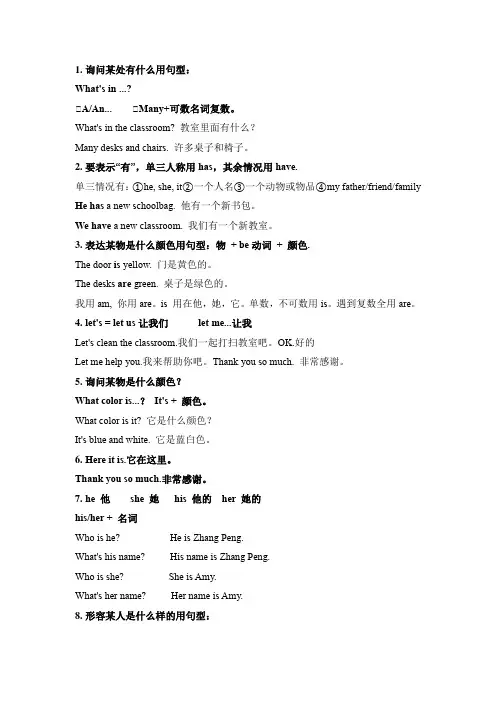
1.询问某处有什么用句型:What's in ...?①A/An... ①Many+可数名词复数。
What's in the classroom? 教室里面有什么?Many desk s and chair s. 许多桌子和椅子。
2.要表示“有”,单三人称用has,其余情况用have.单三情况有:①he, she, it②一个人名③一个动物或物品④my father/friend/family He has a new schoolbag. 他有一个新书包。
We have a new classroom. 我们有一个新教室。
3.表达某物是什么颜色用句型:物+ be动词+ 颜色.The door is yellow. 门是黄色的。
The desks are green. 桌子是绿色的。
我用am, 你用are。
is 用在他,她,它。
单数,不可数用is。
遇到复数全用are。
4.let's = let us让我们let me...让我Let's clean the classroom.我们一起打扫教室吧。
OK.好的Let me help you.我来帮助你吧。
Thank you so much. 非常感谢。
5.询问某物是什么颜色?What color is...?It's + 颜色。
What color is it? 它是什么颜色?It's blue and white. 它是蓝白色。
6.Here it is.它在这里。
Thank you so much.非常感谢。
7.he 他she 她his 他的her 她的his/her + 名词Who is he? He is Zhang Peng.What's his name? His name is Zhang Peng.Who is she? She is Amy.What's her name? Her name is Amy.8.形容某人是什么样的用句型:人+ be动词+形容词。

小学英语PEP四年级上册短语句型汇总汇Words in PEP Book3 (四会单词要求会听、说、读、默写)bag 包pencil 铅笔pen 钢笔book 书ruler 尺子pencil-case 铅笔盒teacher 教师student 学生boy 男孩girl 女孩friend 朋友home 家room 房间school 学校classroom 教室window 窗户desk 课桌;书桌door 门chair 椅子bed 床rice 米饭beef 牛肉bread 面包milk 牛奶egg 蛋water 水chicken 鸡肉 f ish 鱼sister 姐妹brother 兄弟father 父亲;爸爸mother 母亲;妈妈driver 司机doctor 医生farmer 农民nurse 护士Sentences in PEP Book3 (重点句型)Uint1What’s in the classroom? 在教室里有什么?A board, two lights, many desks and chairs一个黑板, 两盏电灯, 许多桌子和椅子……Open the door. 打开门。
Sweep the floor. 扫地板。
Put up the picture. 挂图片。
Turn on the light. 打开灯。
Clean the window. 擦窗户。
Clean the board. 擦黑板。
This is…, our n ew classmate. 这是……,我们的新同学。
Let’s go and have a look. (let’s = let us) 让我们去看一看。
Where’s my seat?It’s near the door. (where 哪里)我的座位在哪里? 它在门附近。
This is my classroom. The wall is white. The floor is green…. (colour)这是我的教室。
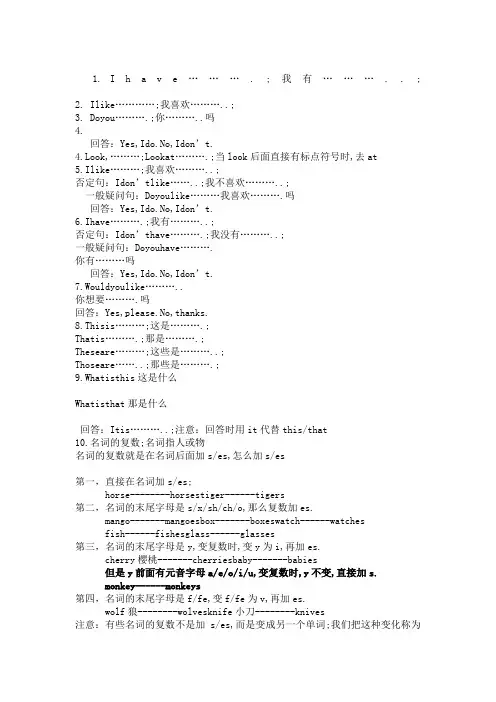
1.I h a v e……….;我有………..;2.Ilike…………;我喜欢………..;3.Doyou……….;你………..吗4.回答:Yes,Ido.No,Idon’t.4.Look,………;Lookat……….;当look后面直接有标点符号时,去at5.Ilike………;我喜欢………..;否定句:Idon’tlike……..;我不喜欢………..;一般疑问句:Doyoulike………我喜欢……….吗回答:Yes,Ido.No,Idon’t.6.Ihave……….;我有………..;否定句:Idon’thave……….;我没有………..;一般疑问句:Doyouhave……….你有………吗回答:Yes,Ido.No,Idon’t.7.Wouldyoulike………..你想要……….吗回答:Yes,please.No,thanks.8.Thisis………;这是……….;Thatis……….;那是……….;Theseare………;这些是………..;Thoseare……..;那些是……….;9.Whatisthis这是什么Whatisthat那是什么回答:Itis………..;注意:回答时用it代替this/that10.名词的复数;名词指人或物名词的复数就是在名词后面加s/es,怎么加s/es第一,直接在名词加s/es;horse--------horsestiger------tigers第二,名词的末尾字母是s/x/sh/ch/o,那么复数加es.mango-------mangoesbox-------boxeswatch------watchesfish------fishesglass------glasses第三,名词的末尾字母是y,变复数时,变y为i,再加es.cherry樱桃-------cherriesbaby-------babies但是y前面有元音字母a/e/o/i/u,变复数时,y不变,直接加s.monkey------monkeys第四,名词的末尾字母是f/fe,变f/fe为v,再加es.wolf狼--------wolvesknife小刀--------knives注意:有些名词的复数不是加s/es,而是变成另一个单词;我们把这种变化称为不规则my-----ourI------wethis-----thesethat-----thoseman-----menwoman-----womenme-----usyou-----youyour-----yourhe/she/it-------theyhim/her/it-----themhis/her/its------their11.Whatarethese这些是什么Whatarethose那些是什么回答:Theyare+人或物复数;注意:回答时,不能出现these/those,而用they代替12.Whatdoyoulike你喜欢什么回答:Ilike………;13.Whatdoyouhave你有什么回答:Ihave……….;14.Howmany+人或物复数doyouhave你有多少个人或物回答:Ihave+数量…….;howmany+人或物复数是对数量提问15.Ihave+物;对Ihave后面的物划线提问,用Whatdoyouhave16.Ilike+物;对Ilike后面的物划线提问,用Whatdoyoulike17.I’dlike………;我想要……….;否定句:I’dnotlike……….;我不想要………;I’dnot=Iwouldn’t一般疑问句:Wouldyoulike……..你想要………吗回答:Yes,please.No,thanks.18.对I’dlike后面的物划线提问,用Whatwouldyoulike如:I’dlike+物;Whatwouldyoulike19.对Ihave后面的数量划线提问,用Howmany+人或物复数+doyouhave如:Ihave+数量+人或物;Howmany+人或物复数+doyouhave20.Canyou+动词……..你会………吗Yes,Ican.No,Ican’t.CanIhavealook回答:Sure/OK.Can+其他人+动词……..某人会……….吗回答:Yes,he/she/theycan.No,he/she/theycan’t.21.Ican+动词………;我会………;否定句:Icannot+动词…….;我不会……..;一般疑问句:Canyou+动词………你会………吗回答:Yes,Ican.No,Ican’t.其他人+can+动词………;某人会……….;否定句:其他人cannot+动词…….;某人不会……..;一般疑问句:Can其他人+动词………某人会………吗回答:Yes,he/she/theycan.No,he/she/theycan’t.22.改否定句1.Idon’tlike……..;2.Idon’thave……..;3.Iwouldn’tlike………;4.人+can’t………;5.在am/is/are后面加not.23.改一般疑问句1.Doyoulike……..2.Doyouhave………3.Wouldyoulike………4.Can+人……….5.把am/is/are放在句首;改疑问句时,把my/our改成your,I/we/me/us改成you24.Whereis/are+人或物人或物是复数,用are;人或物是单数,用is问某人或物在哪儿回答:he/she/itis+地点;They+地点;地点指在某个地方;译成英文:介词+地方介词:in,on,at,under,behind,beside,near,for25.根据第22句型和第23句型Thisis……..;否定句Thisisnot……..Thatis………否定句Thatisnot……..Theseare…….否定句Thesearenot………Thoseare……..否定句Thosearenot…….Thisis………一般疑问句Isthis…….这是……..吗Thatis………一般疑问句Isthat…….那是………吗回答:Yes,he/she/itisNo,he/she/itisn’tthis/that指物,回答时用it;this/that指物,回答时用he/sheTheseare……..改一般疑问句Arethese……..这些是……..吗Thoseare…….改一般疑问句Arethose…….那些是…….吗回答:Yes,theyareNo,theyaren’tthese/those是复数,不管表示人或物,回答时都用they26改感叹句Howcute多么可爱啊Whatanicecake一块多么漂亮的蛋糕啊形容词后面没有人或物时,感叹句用how开头;形容词后面有人或物时,感叹句用what开头;27.想要wouldlike=want1.Iwouldlike=Iwant我想要2.Iwouldn’tlike=Idon’twant我不想要3.Wouldyoulike……=Doyouwant……..你想要………吗28.对Icanplay后面的物划线提问,用Whatcanyouplay回答用Yes,Ican.No,Ican’t.Icanplaybasketball.划线提问Whatcanyouplay对Ican后面的动词划线提问,用Whatcanyoudo回答用Ican….Icanplaybasketball.划线提问WhatcanyoudoIcanswim.划线提问Whatcanyouplay29.对人+canplay后面的物划线提问,用Whatcan人play某人会玩什么回答用人+can+play……某人会玩……Shecanplaybasketball.划线提问Whatcansheplay30.对人+can后面的动词划线提问,用Whatcan人do某人会做什么回答用人+can……某人会……Liutaocanplaybasketball.划线提问WhatcanLiutaodo31.我们以前学习过:当人或物的数量大于1时,这个人或物要用复数;但是在四年级上册Unit6里提到有少数的物是不可数名词coffee,tea,juice,milk,blacktea,water,rice,chocolate,bread.不可数名词的数量只有some/any;尽管数量大于1,不可数名词只用单数形式;不可数名词不能直接加数字如:“一杯茶”不能说成“atea”,而是“acupoftea”;不可数名词的具体数量是用“数字+单位+of+不可数名词”表示;如:两杯咖啡twocupsofcoffee.用物主代词;33.Howmuchis/are+物对价钱提问回答用Itis/Theyare…….;34.socks/shoes是复数,如果用apairof表示shoes/socks的数量,pair是单数,apairofshoes/socks是单数;pair是复数,那么pairsofshoes/socks是复数;如:Apairofshoesiswhite.Fivepairsofsocksareforme.35.Howmany+人或物复数wouldyoulike回答:I’dlike+数量;36.Itistime…..;该是……..的时候;用法:Itistimefor+人或物/Itistimeto+动词;该是做某事的时候该是打篮球的时候;Itistimeforbasketball./Itistimetoplaybasketball.该是吃午饭的时候;Itistimeforlunch./Itistimetohavelunch.36.Whois/are/am+人某人是谁who对人提问;37改一般疑问句Iam变成Areyou,Weare变成Areyou,还有my/our改成your,i/we/me/us改成you1.把am/is/are移到句首;Heismybrother.------一般疑问句-------IsheyourbrotherIamfat.------一般疑问句-------AreyoufatWearetall.------一般疑问句-------Areyoutall2.把can移到句首;Icanplaybasketball.-----一般疑问句-------CanyouplaybasketballMikecanskate-----一般疑问句-------CanMikeskate3.把would移到句首.改疑问句和否定句时,把some变成any,可有wouldlike时,some不变;I’dlikesomerice.-----一般疑问句-------Wouldyoulikesomerice4.如果没有am/is/are/can/would时,就用do放在句首;但是,动词后面有s/es并且动词前面的人是第三人称单数,那么就用does移到句首;有does时,动词后面的s/es去掉Ihavesomestickers.-----一般疑问句-------DoyouhaveanystickersTheyplaytabletennis.-----一般疑问句----DotheyplaytabletennisMikeplaysbasketball.-----一般疑问句-----DoesMikeplaybasketball39.Whatsubjectsdoyoulike你喜欢什么学科对课程划线提问;回答用Ilike开头;IlikePE.划线提问Whatsubjectdoyoulike40Whatlessonsdoyouhave你上什么课对课划线提问;回答用Ihave开头;IhavePE.划线提问Whatlessondoyouhave41改否定句注意:把some改成any,有wouldlike时,还用some;把too改成either;把and改成or1.在am/is/are后加not;Heismybrother.------否定句-------Heisnotmybrother.Iamfatandtall.------否定句-------Iamnotfatortall.Wearesomeboys.------否定句-------We aren’t anyboys.2.在can后面加not;Icanplaybasketball,too.-----否定句------Ican’t playbasketballeither.Mikecanskate-----否定句-------Mikecannotskate.3.在would后面加not.I’dlikesomerice.-----否定句-------Iwouldn’tlikesomerice.Hewouldlikesomecoffee,too.-------否定句------Hewouldnotlikesomecoffeeeither.4.如果没有am/is/are/can/would时,就用do加not;donot放在动词前面;但是,动词后面有s/es并且动词前面的人是第三人称单数,那么就用does加not,doesnot放在动词前面;有does时,动词后面的s/es去掉Ihavesomestickers.-----否定句-------Idonothaveanystickers.Theyplaytabletennis.-----否定句----Theydonotplaytabletennis.Mikeplaysbasketball.------否定句-----Mikedoesnotplaybasketball.注意:arenot=aren’tisnot=isn’t cannot=can’twouldnot=would n’tdonot=don’t42.划线提问:就是用疑问词对被划线的单词或词组进行提问;注意:被划线的单词或词组属于哪一类1现在,先了解疑问词:Who对人划线提问what对物划线提问whose加人或物对名词所有格或形容词性物主代词划线提问;把被划线名词所有格或形容词性物主代词后面的人或物放在whose后面where对地点划线提问;when对在何时划线提问;在何时就是指在某个时间,如onMonday,today whattime几点几分划线提问;whatcolour对颜色划线提问;被划线颜色要单独使用,后面无人或物Whatlesson s对什么课划线提问;whatsubject s对什么学科划线提问;How对形容词划线提问;被划线形容词要单独使用,后面没有人或物Howmany加人或物复数对可数名词前的数量划线提问把被划线数量后面的人或物放在Howmany后面Howmuch对价钱划线提问;Howold对年龄划线提问;那么做划线提问的句型:疑问词+助动词助动词来自原句+其他部分把原句从头抄到尾,但是被划线的单词或词组不抄助动词:amisarecanwoulddodoes43.动词就是指动作的词;如:run,swim,have….第三人称指除了我们和你们以外的人/物;如:mysister是第三人称; 当动词前面的人/物是第三人称单数时,动词后面加s/es.Mysister plays playtabletennis.I swim swimintheriver.I不是第三人称,而是第一人称动词后面加s/es的方法与名词后面的s/es的方法一样;(1)直接在动词后面加sswim--------swims2如果动词末尾字母是x,ch,sh,o,s时,动词后面加es;go---------goes3动词的末尾字母是y,变y为i,再加es.fly-----flies但是y前面有元音字母时,y不变,直接加s.play------plays4在动词后面加s/es时,只有一个不规则变化;have------hasMysister has havelonghair.动词后面加s/es,称之为动词的第三人称单数形式;。

四年级英语语法句型四年级英语语法主要包括句子结构、基本句型、时态、单复数等。
下面将详细介绍这些内容。
一、句子结构在英语中,一个完整的句子通常由主语、谓语和宾语构成。
主语是句子的主要话题或执行动作的人或物,谓语是描述主语动作或状态的部分,而宾语是谓语动作的承受者或影响者。
例句1:Tom is playing football.(汤姆正在踢足球。
)主语:Tom谓语:is playing宾语:football例句2:She has a cat.(她有一只猫。
)主语:She谓语:has宾语:a cat二、基本句型1. 主谓句型(S+V)主谓句型是最简单也是最基本的句型,在句子中表示一个人或物的行为或状态。
例句:My mother cooks dinner.(我的妈妈做晚饭。
)2. 主谓宾句型(S+V+O)主谓宾句型是在主谓句型的基础上加上一个宾语,用来表示主语对宾语的影响或动作。
例句:I eat an apple.(我吃一个苹果。
)3. 主系表句型(S+V+P)主系表句型是在主谓句型的基础上加上一个表语,用来描述主语的特征、状态或属性。
例句:The flower is beautiful.(这朵花很美。
)4. 主谓宾宾句型(S+V+O+O)主谓宾宾句型是在主谓宾句型的基础上加上第二个宾语,用来表示主语对两个宾语的影响或动作。
例句:She gave me a book.(她给了我一本书。
)5. There be句型There be句型表示某处存在某物或某人。
例句:There is a cat in the garden.(花园里有一只猫。
)三、时态时态是表示动作发生的时间的方式。
在英语中,常用的时态包括一般现在时、一般过去时和一般将来时。
1. 一般现在时一般现在时表示经常性或普遍性的动作、习惯、真理或现状。
例句:I go to school every day.(我每天上学。
)2. 一般过去时一般过去时表示过去某个时间发生的动作或状态。
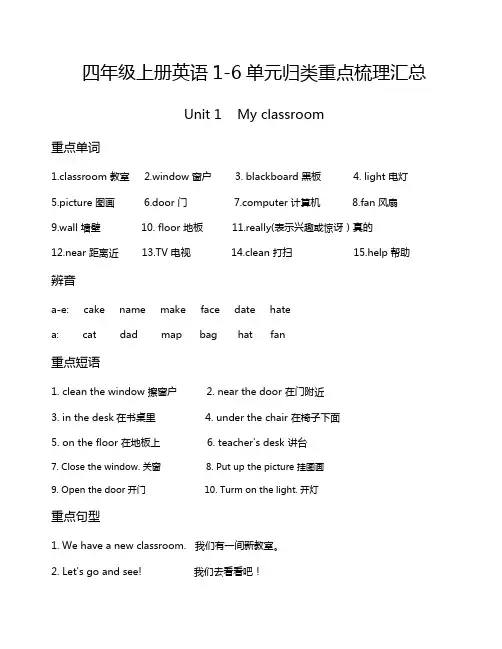
四年级上册英语1-6单元归类重点梳理汇总Unit 1 My classroom重点单词1.classroom 教室2.window 窗户3. blackboard 黑板4. light 电灯5.picture 图画6.door 门puter 计算机8.fan 风扇9.wall 墙壁 10. floor 地板 11.really(表示兴趣或惊讶)真的12.near 距离近 电视 14.clean 打扫 15.help帮助辨音a-e: cake name make face date hatea: cat dad map bag hat fan重点短语1. clean the window 擦窗户2. near the door 在门附近3. in the desk在书桌里4. under the chair 在椅子下面5. on the floor 在地板上6. teacher's desk 讲台7. Close the window. 关窗 8. Put up the picture 挂图画9. Open the door 开门 10. Turm on the light. 开灯重点句型1.We have a new classroom. 我们有一间新教室。
2. Let's go and see! 我们去看看吧!3. Let's clean the classroom! 我们打扫教室吧!4. Where is it? 它在哪儿?5. It's near the window. 就在窗户旁边。
6. Let me clean the windows. 我来擦窗户。
重点语法1.【原文】What's in the classroom?教室里面有什么?【简析】What's+介词(in,under,on)+the+名词(classroom,desk,chair……)?意为“某处有什么?"what's是what is的缩写形式。
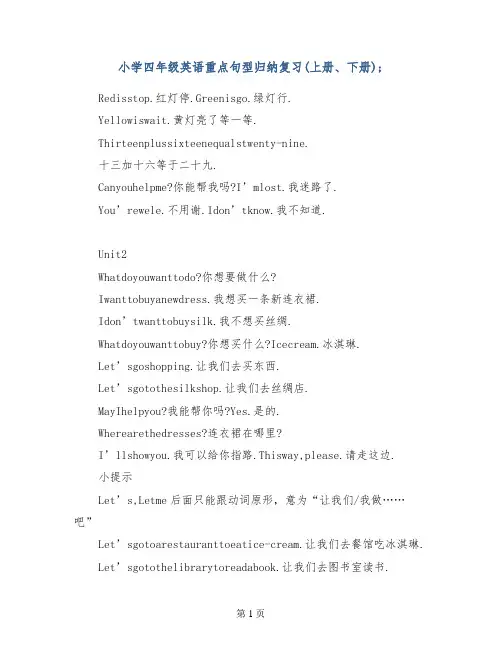
小学四年级英语重点句型归纳复习(上册、下册);Redisstop.红灯停.Greenisgo.绿灯行.Yellowiswait.黄灯亮了等一等.Thirteenplussixteenequalstwenty-nine.十三加十六等于二十九.Canyouhelpme?你能帮我吗?I’mlost.我迷路了.You’rewele.不用谢.Idon’tknow.我不知道.Unit2Whatdoyouwanttodo?你想要做什么?Iwanttobuyanewdress.我想买一条新连衣裙.I don’twanttobuysilk.我不想买丝绸.Whatdoyouwanttobuy?你想买什么?Icecream.冰淇琳.Let’sgoshopping.让我们去买东西.Let’sgotothesilkshop.让我们去丝绸店.MayIhelpyou?我能帮你吗?Yes.是的.Wherearethedresses?连衣裙在哪里?I’llshowyou.我可以给你指路.Thisway,please.请走这边.小提示Let’s,Letme后面只能跟动词原形,意为“让我们/我做……吧”Le t’sgotoarestauranttoeatice-cream.让我们去餐馆吃冰淇琳.Let’sgotothelibrarytoreadabook.让我们去图书室读书.Awaiterworksinarestaurant.服务员在餐馆工作. Aclerkworksinastore.办事员在商店工作. Abusinessmanworksinaofficebuilding.商人在办公楼工作. Winter:Theweatheriscoldandsnowy.天气是寒冷的和多雪的Spring:Itiswarmandrainy.天气是暖和的和多雨的. Summer:It’shotandsunny.天气是炎热的和晴朗的.; Autumn:Theweatheriswindyandcloudy.天气是多风的和多云的.Whereareyougoing?你要去哪里? Tothebicycleshopacrossthestreet.去街对面的自行车商店. Why?为什么.Mybikeisbroken.我的自行车坏了. Ineedanewchain.我需要一个新链条.Acathasfur,pawsandatail.猫有毛皮、爪子和一条尾巴。
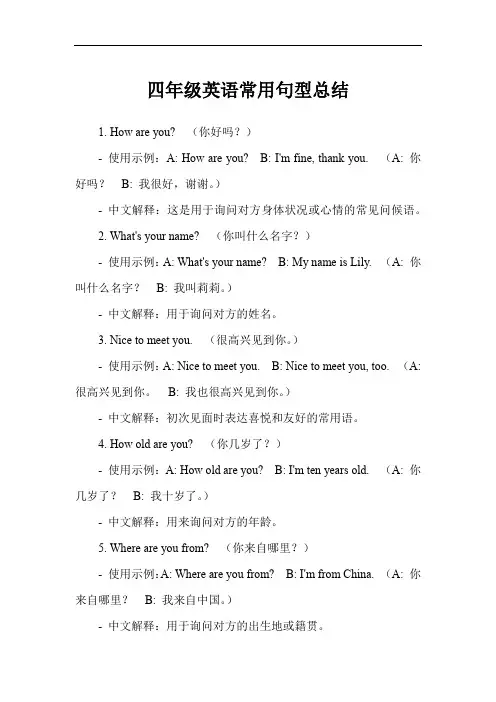
四年级英语常用句型总结1. How are you? (你好吗?)-使用示例:A: How are you? B: I'm fine, thank you. (A: 你好吗?B: 我很好,谢谢。
)-中文解释:这是用于询问对方身体状况或心情的常见问候语。
2. What's your name? (你叫什么名字?)-使用示例:A: What's your name? B: My name is Lily. (A: 你叫什么名字?B: 我叫莉莉。
)-中文解释:用于询问对方的姓名。
3. Nice to meet you. (很高兴见到你。
)-使用示例:A: Nice to meet you. B: Nice to meet you, too. (A: 很高兴见到你。
B: 我也很高兴见到你。
)-中文解释:初次见面时表达喜悦和友好的常用语。
4. How old are you? (你几岁了?)-使用示例:A: How old are you? B: I'm ten years old. (A: 你几岁了?B: 我十岁了。
)-中文解释:用来询问对方的年龄。
5. Where are you from? (你来自哪里?)-使用示例:A: Where are you from? B: I'm from China. (A: 你来自哪里?B: 我来自中国。
)-中文解释:用于询问对方的出生地或籍贯。
6. How many classrooms are there in your school? (你们学校有多少间教室?)示例:There are twenty classrooms in my school. (我们学校有二十间教室。
)中文解释:用于询问学校里教室的数量。
7. What subjects do you have today? (你今天有什么科目?)示例:I have Maths, English and Chinese today. (我今天有数学、英语和语文。
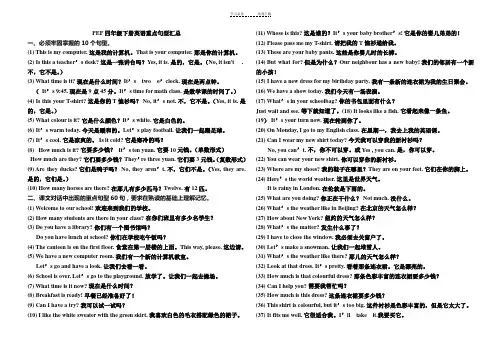
PEP四年级下册英语重点句型汇总一、必须牢固掌握的10个句型。
(1) This is my computer. 这是我的计算机。
That is your computer. 那是你的计算机。
(2) Is this a teacher’s desk? 这是一张讲台吗?Yes, it is. 是的,它是。
(No, it isn't .不,它不是。
)(3) What time is it? 现在是什么时间?It’s two o’clock. 现在是两点钟。
(It’s 9:45. 现在是9点45分。
It’s time for math class. 是数学课的时间了。
)(4) Is this your T-shirt? 这是你的T恤衫吗? No, it’s not. 不,它不是。
(Yes, it is. 是的,它是。
)(5) What colour is it? 它是什么颜色?It’s white. 它是白色的。
(6) It’s warm today. 今天是暖和的。
Let’s play football. 让我们一起踢足球。
(7) It’s cool. 它是凉爽的。
Is it cold? 它是寒冷的吗?(8) How much is it? 它要多少钱?It’s ten yuan. 它要10元钱。
(单数形式)How much are they? 它们要多少钱?They’re three yuan. 它们要3元钱。
(复数形式)(9) Are they ducks? 它们是鸭子吗? No, they aren’t. 不,它们不是。
(Yes, they are.是的,它们是。
)(10) How many horses are there? 在那儿有多少匹马?Twelve. 有12匹。
二、课文对话中出现的重点句型60句,要求在熟读的基础上理解记忆。
(1) Welcome to our school! 欢迎来到我们的学校。
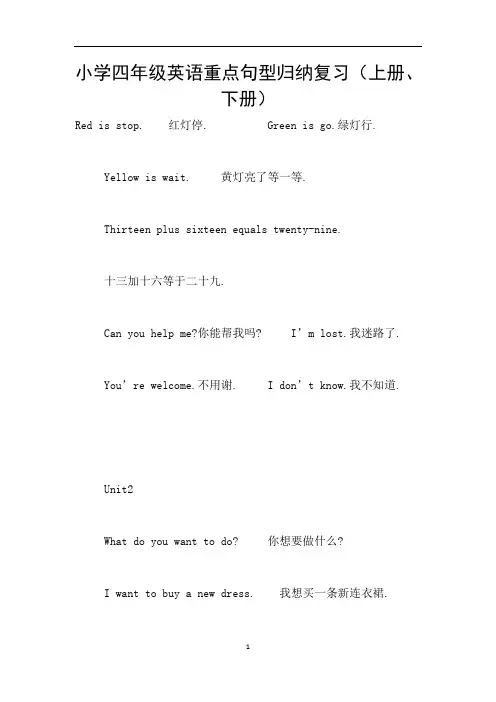
小学四年级英语重点句型归纳复习(上册、下册)Red is stop. 红灯停. Green is go.绿灯行.Yellow is wait. 黄灯亮了等一等.Thirteen plus sixteen equals twenty-nine.十三加十六等于二十九.Can you help me?你能帮我吗? I’m lost.我迷路了.You’re welcome.不用谢. I don’t know.我不知道.Unit2What do you want to do? 你想要做什么?I want to buy a new dress. 我想买一条新连衣裙.I don’t want to buy silk. 我不想买丝绸.What do you want to buy?你想买什么?Ice cream.冰淇琳.Let’s go shopping. 让我们去买东西.Let’s go to the silk shop. 让我们去丝绸店.May I help you? 我能帮你吗? Yes. 是的.Where are the dresses? 连衣裙在哪里?I’ll show you.我可以给你指路.This way,please.请走这边.小提示:Let’s,Let me后面只能跟动词原形,意为“让我们/我做……吧”Let’s go to a restaurant to eat ice-cream.让我们去餐馆吃冰淇琳.Let’s go to the library to read a book.让我们去图书室读书.A waiter works in a restaurant.服务员在餐馆工作.A clerk works in a store. 办事员在商店工作.A businessman works in a office building.商人在办公楼工作.Winter: The weather is cold and snowy.天气是寒冷的和多雪的Spring: It is warm and rainy.天气是暖和的和多雨的.Summer: It’s hot and sunny. 天气是炎热的和晴朗的.Autumn: The weather is windy and cloudy.天气是多风的和多云的.Where are you going? 你要去哪里?To the bicycle shop across the street.去街对面的自行车商店.Why? 为什么. My bike is broken.我的自行车坏了.I need a new chain. 我需要一个新链条.A cat has fur,paws and a tail.猫有毛皮、爪子和一条尾巴。
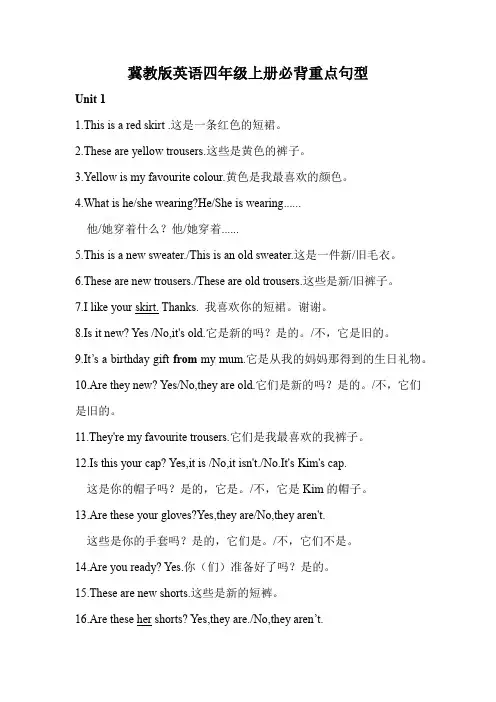
冀教版英语四年级上册必背重点句型Unit 11.This is a red skirt .这是一条红色的短裙。
2.These are yellow trousers.这些是黄色的裤子。
3.Yellow is my favourite colour.黄色是我最喜欢的颜色。
4.What is he/she wearing?He/She is wearing......他/她穿着什么?他/她穿着......5.This is a new sweater./This is an old sweater.这是一件新/旧毛衣。
6.These are new trousers./These are old trousers.这些是新/旧裤子。
7.I like your skirt. Thanks. 我喜欢你的短裙。
谢谢。
8.Is it new? Yes /No,it's old.它是新的吗?是的。
/不,它是旧的。
9.It’s a birthday gift from my mum.它是从我的妈妈那得到的生日礼物。
10.Are they new? Yes/No,they are old.它们是新的吗?是的。
/不,它们是旧的。
11.They're my favourite trousers.它们是我最喜欢的我裤子。
12.Is this your cap? Yes,it is /No,it isn't./No.It's Kim's cap.这是你的帽子吗?是的,它是。
/不,它是Kim的帽子。
13.Are these your gloves?Yes,they are/No,they aren't.这些是你的手套吗?是的,它们是。
/不,它们不是。
14.Are you ready? Yes.你(们)准备好了吗?是的。
15.These are new shorts.这些是新的短裤。
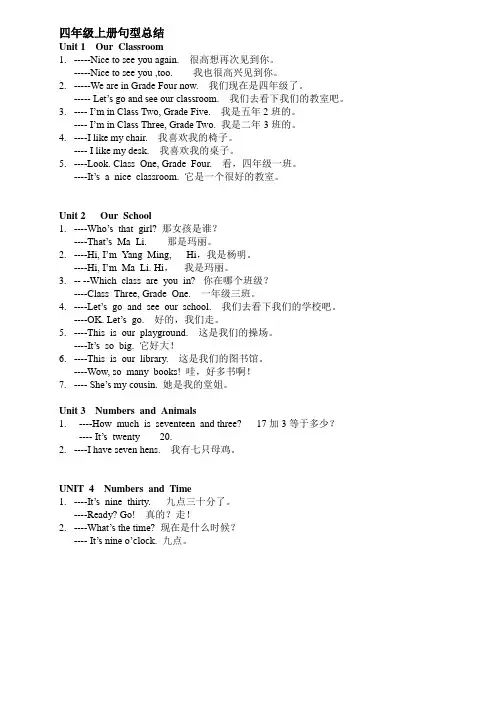
四年级上册句型总结Unit 1 Our Classroom1.-----Nice to see you again. 很高想再次见到你。
-----Nice to see you ,too. 我也很高兴见到你。
2.-----We are in Grade Four now. 我们现在是四年级了。
----- Let’s go and see our classroom. 我们去看下我们的教室吧。
3.---- I’m in Class Two, Grade Five. 我是五年2班的。
---- I’m in Class Three, Grade Two. 我是二年3班的。
4.----I like my chair. 我喜欢我的椅子。
---- I like my desk. 我喜欢我的桌子。
5.----Look. Class One, Grade Four. 看,四年级一班。
----It’s a nice classroom. 它是一个很好的教室。
Unit 2 Our School1.----Who’s that girl? 那女孩是谁?----That’s Ma Li. 那是玛丽。
2.----Hi, I’m Yang Ming, Hi,我是杨明。
----Hi, I’m Ma Li. Hi,我是玛丽。
3.-- --Which class are you in? 你在哪个班级?----Class Three, Grade One. 一年级三班。
4.----Let’s go and see our school. 我们去看下我们的学校吧。
----OK. Let’s go. 好的,我们走。
5.----This is our playground. 这是我们的操场。
----It’s so big. 它好大!6.----This is our library. 这是我们的图书馆。
----Wow, so many books! 哇,好多书啊!7.---- She’s my cousin.她是我的堂姐。
四年级英语句型四年级是学习英语的重要阶段之一,学生需要掌握一些基本的句型来进行日常交流和表达。
下面将详细介绍四年级英语常用句型,并给出一些例句以便理解和记忆。
1. 主语 + be动词 + 形容词这个句型用于描述事物的特征和状态。
例句:- The cat is cute.(这只猫很可爱。
)- The flowers are beautiful.(这些花很漂亮。
)2. 主语 + 动词原形 + 宾语这个句型用于表示主语进行的动作。
例句:- I like pizza.(我喜欢比萨饼。
)- They play basketball.(他们打篮球。
)3. 主语 + have/has + 宾语这个句型用于表示主语拥有某样东西。
例句:- She has a new bike.(她有一辆新自行车。
)- We have two dogs.(我们有两只狗。
)4. What + be动词 + 主语 + doing?这个句型用于询问某人正在做什么。
例句:- What are you doing?(你在做什么?)- What is he doing?(他在做什么?)5. Yes/No问句这个句型用于提出简单的是非问题,回答时只需要使用Yes或No。
例句:- Do you like ice cream?(你喜欢冰淇淋吗?)- Is she your friend?(她是你的朋友吗?)6. What + be动词 + 主语 + like?这个句型用于询问某人喜欢什么。
例句:- What do you like?(你喜欢什么?)- What does he like?(他喜欢什么?)7. There is/are + 宾语这个句型用于描述某地或某处有什么东西。
例句:- There is a book on the table.(桌子上有一本书。
)- There are many trees in the park.(公园里有很多树。
湘少版四年级下句型归纳Unit 11.—Where’s my new cap? (我的新帽子在哪儿?)—It’s on your head.(在你头上。
)2.—Where are my glasses. (我的眼镜在哪儿?)—They’re in the bag.(在你的包里。
)3. It’s under the desk.(它在桌子下。
)4. I put it on my desk.(我把它放我桌上了。
)5. Here it is.(在这里。
)6. You’re clever.(你真聪明。
)Unit 21.Spring is warm.(春天是温暖的。
)2..Summer is hot.(夏天是炎热的。
)3.Autumn is cool.(秋天是凉爽的。
)4..Winter is cold.(冬天是寒冷的。
)5. I’m from Changsha.(我来自长沙。
)6.I like winter in Kunming.(我喜欢昆明的冬天。
)7.Beijing is cool in autumn.(秋天,北京很凉爽。
)8. It’s hot in Sanya.(三亚很热。
)9. —What’s the weather like here? (这里天气怎么样?)—It’s very cold.(很冷)10. You can’t wear my jumper! (你不能穿我的跳跃服。
)11. Be careful! (小心!)12.Winter is snowy.(冬天下雪。
)Unit 31.—What can you see? (你能看见什么?)—I can see a river.(我能看见一条河。
)—I can see white clouds and the blue sky. (我能看见白云和蓝天。
)2.What can you see in the picture? (在图片中你能看到什么?)3. Look down! (往下看!)4. It’s nice!(真漂亮!)5.You can see a town.(你能看见一个小镇。
四下各单元句型总结Unit 1 He looks like a cook1.A: W hich one / boy/ girl / man / woman is …? 哪一个是…?(在一定选择范围内)B: The one + 介词短语.e.g. A: Look at these children. Which one is Ben?B: The one with glasses and in a blue shirt (is Ben).2.A: W ho is …? ...是谁?B: He/She is + 人名.B: He/She is + 身份.e.g. A: Who is Ms White?B: She is our teacher.A: Who is the girl with long hair?B: She is Janet, my friend.Unit 2 She is very kind1.A: What is he/she like? 他/她是一个怎么样的人? (从性格、外貌、爱好等方面回答)B: He/ She has + 外貌特征B: He/ She is + 性格或外貌的形容词B: He/ She looks + 性格或外貌的形容词**look + 形容词,表示“看起来怎么样”;look like + 名词,表示“看起来像…”e.g. A: What is your brother like?B: He has a round face, two big eyes and a small nose. He looks/ is lovely. He likes eating.Unit 3 It’s time to get up1.A: What time is it? / What is the time? (现在是几点?)B: It’s + 时间点。
e.g. A: What time is it now?B: It is eight o’clock now.2.It is time for + 名词。
人教版四年级英语上册句型总结1、We have a new classroom, 我们有一间新的教室。
It’s so big. 它很大1、What’s in the classroom ? 教室里面有什么?One blackboard、one TV、many desks and chairs.有一块黑板、一台电视、许多的课桌和椅子。
2 Let’s clean the classroom .让我们一起打扫教室吧。
① OK. 好。
② Good idea . 好主意。
③ All right .好的。
3、Let me clean the teacher’s desk.。
让我来擦讲桌。
4、Let me clean the windows. 让我来擦窗子。
5、Let me help you. 让我来帮助你。
Thank you. 谢谢6、Where’s my seat ?我的座位在哪里?Let’s go and see.让我们一起去看一看吧7、Where is it?它在哪里?It’s near the window.它在窗子的附近。
It’s in the desk. 它在桌箱里面。
It’s on the teacher’s desk. 它在讲桌上。
It’s under the chair. 它在椅子的下面。
8、This is the new classroom. 这是新的教室。
The door is orange. 门是橙色的。
The desks are green. 课桌是绿色的。
I like my classroom. 我喜欢我的教室。
9、Wha t’s in your schoolbag?你的书包里有什么?An English book、a Chinese book、a maths book and three storybooks.有一本英语书、一本语文书、一本数学书和三本故事书。
Three keys、two toys and an English book 三把钥匙、两个玩具和一本英语书。
各单元必须要掌握的重点句型★Unit 11. ----Where is it?它在哪儿?----It’s near the window. 它在窗户的旁边.2. ----What’s in the classroom?教室里有什么?----One blackboard, one TV, many desks and chairs. 一块黑板,一台电视,许多的桌子和椅子。
3. ----Let’s clean the classroom! 我们打扫教室吧。
----OK. 好。
4. ----Let me help you. 让我帮你吧!----Thank you. 谢谢你。
5. ----We have a new classroom.我们有了一间新的教室。
----Really?真的吗?★Unit 21. ----What’s in your schoolbag?你的书包里有什么?----An English book and a Chinese book. 一本英语书,一本语文书。
2. ----What colour is it?它是什么的?----It's blue and white. 它是蓝白色的。
3. ----Here it is!它在这儿。
----Thank you so much!非常感谢。
4. Excuse me. I lost my schoolbag. 打扰一下,我丢失了★Unit 31. ----A boy or girl?男孩还是女孩?----A boy. 男孩。
2. ----What’s his name?他叫什么名字?----His name is Zhang Peng. 他叫张鹏。
3. ----What’s her name?她的名字叫什么?----Her name is Amy. 她的名字叫Amy.4. ----Who is he?他是谁?----His name is Wu Yi fan. 他叫吴一凡.5. ----Who’s she?她是谁?----She is Miss White. 她是怀特老师。
小学四年级英语重点句型及语法规则一、简单句的构成英语的简单句由主语和谓语组成,主语通常是句子的主题,而谓语则描述主语的动作或状态。
例如:•主语 + 谓语:Tom eats an apple.•主语 + 系动词 + 表语:She is tall.二、五大时态在英语中,动词的时态是用来表示动作发生的时间。
小学四年级中,学生们需要掌握五个基本时态:一般现在时、一般过去时、一般将来时、现在进行时和过去进行时。
1. 一般现在时一般现在时用于描述经常发生的动作、情况或普遍真理。
肯定句结构:主语 + 动词原形 + 其他例如:•I play basketball after school.•She likes to sing songs.否定句结构:主语 + do/does + not + 动词原形 + 其他例如:•I do not play basketball after school.•She does not like to sing songs.疑问句结构:Do/Does + 主语 + 动词原形 + 其他?例如:•Do you play basketball after school? •Does she like to sing songs?2. 一般过去时一般过去时用于描述过去发生的动作或情况。
肯定句结构:主语 + 动词过去式 + 其他例如:•I played basketball yesterday.•She danced at the party last night.否定句结构:主语 + did not + 动词原形 + 其他例如:•I did not play basketball yesterday.•She did not dance at the party last night.疑问句结构:Did + 主语 + 动词原形 + 其他?例如:•Did you play basketball yesterday?•Did she dance at the party last night?3. 一般将来时一般将来时用于描述将来发生的动作或情况。
1.She lives in Shanghai. (就画线部分提问)
2.He's got a new friend. (一般疑问句)
3.I'm from China. (就画线部分提问)
4.I'm nine years old. (就画线部分提问)
5.He's from Canada.(同义句) He _______ ________ Canada.
6.You are an Englishman.(否定句)
7.They helped the children. (否定句)
8.He helped the old grandparents. (一般疑问句)
9.Did he clean the room? (否定回答)
10.She lives in Hong Kong. (否定句)
11.I went to school yesterday morning. (一般疑问句)
12.He cooked a dinner for us. (一般疑问句)
13.They often help other people. (一般疑问句)
14.My grandma usually painted. (一般疑问句)
15.They watched a football match yesterday. (对画线部分提问)
16.He gets up at eight twelve. (否定句)
17.She usually walks back home. (否定句)
18.Yesterday was his birthday. (否定句)
19.Lingling painted a picture and wrote a letter. (否定句)
20.She's got a pretty dress. (否定句)
21.They played on playground.(一般疑问句)
22.He likes cooking at home. (一般疑问句)
23.Mary is studying now. (一般疑问句)
24.Did you clean your room? (否定回答)
25.Were there some good things? (肯定回答)
26.She learned these things yesterday.(否定句)
27.They walked to school yesterday.(否定句)
28.He washes some dishes every evening. (否定句)
29.She didn't get up at seven thirty. (同义句)
30.They go to school by bike. (同义句)
31.She learned Maths yesterday.(对画线部分提问)
32.My aunt usually walks to work. (一般疑问句)
33.The little boy played with his brother. (就画线部分提问)
34.We usually go to school on Mondays. (对画线部分提问)
35.It was raining.(就天气提问)
36.Ms Guo was a good teacher.(否定句)
37.American people invented the phone.(否定句)
38.Chinese people invented printing.(一般疑问句)
39.It's a good idea.(感叹句)
40.Look at the man on the bicycle.(否定句)
41.We went swimming yesterday evening.(否定句)
42.They were good friends.(一般疑问句)
43.Did you learn the music?(否定句)
44.He goes to school by bus.(否定句)
45.My mother bought a new clothes.(一般疑问句)
46.They walked in the street.(就画线部分提问)
47.He saw a film yesterday evening.(否定句)
48.They bought a cake for me.(同义句)
49.They walked to school.(同上)
50.He looks like his father.(改为过去时态)
51.We went swimming.(否定句)
52.My mum bought me a birthday cake.(同义句)
53.He learns to skate on the ice.(一般疑问句)
54.Was the school trip very good? (肯定回答)
55.They saw lots of mountains.(同义句)
56.We usually swim on Saturday evening. (同上)
.We usually _____ _____ on Saturday evening.
57.Li Xiaoming ate apples during the meal.(一般疑问句)
58.They wore some warm clothes.(就画线部分提问)
59.We have a lovely day.(同义句) We have a ____________ day.
60.We enjoyed ourselves yesterday. (同上)
We ______ ________ ________ _________ yesterday.
61.She usually learn English and Maths. (否定句)
62.They walk to school every day.(用yesterday改写)
63.Mrs Betty phoned my grandma yesterday evening.(否定句)
64.She's playing with her little dog.(就画线部分提问)
65.He loves computer games too.(一般疑问句)
66.Father bought me a funny dog.(同义句)
67.You have got a lot of money in your pocket.(同义句)
68.My mother often washes the clothes.(同义句)
69.He's from England.(同义句)
70.Amy was a good student.(否定句)
71.An American man invented bicycle.(变否定句)
72.An American man didn't invent telephone. (变肯定句)
73.Chinese people invented paper.(就画线部分提问)
74.I went out.(变成否定句)
75.I saw tigers.(变成一般疑问句并作否定回答)
76.They went to London.(就画线部分提问)
77.Yesterday Daming went swimming. (就画线部分提问)
78.I fell over. (变成一般疑问句并作肯定回答)
77.She cut her finger.(变否定句)
78.I bumped my leg. (就画线部分提问)
79.He goes to the zoo. (改成含有last Sunday的句子)
80.We bought a watermelon.(变成一般疑问句并做否定回答)
81.I didn't go for a bike ride. (改成肯定句)
82.She went to London.(就画线部分提问)
83.He went swimming yesterday. (就画线部分提问)
84.She's got a headache. (就画线部分提问)
85.There was a monster on the TV. (改成否定句)。